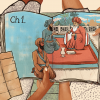Kanupriya Dhawan: Why did you write on someone like Radha?
H.S. Shivaprakash: I have been deeply interested in different aspects of the Bhakti tradition, the tradition which was largely ignored by historians and art historians. Hindu nationalists, leftists, the mainstream leftists were not interested in it, except individual Marxists like D.D. Kosambi. The formalists, modernists and Dalits were also not interested in it. Though Ambedkar’s father was a Kabirpanthi, Ambedkar saw the decadence of Varkari panth of Maharashtra and he developed a kind of distaste for bhakti traditions. Some members of the Dravidian movement, because of their atheism, also completely ignored the significance of bhakti traditions. Of course, some literary histories of different languages do talk about the contribution of bhakti, literary contributions of bhakti poets and writers, but the larger contribution that the bhakti tradition had made to the scenario of arts and aesthetics of India for nearly a millenium was not studied extensively. So, I got into Bhakti because in my Marxist days I was looking for some native literary models of progressive cultural politics in India, and also because I was brought up in a family of Veerashaivas. Veerashaivas belong to a reformatory form of religion. I won’t call it Hinduism. Veerashaivism is like Sikhism in the north, which does not favour temples, idol worship, gender discrimination, the caste system, and so on. Because of this background and my interests in Marxism, I began to study Bhakti traditions. First in my own tradition and then its counterparts in other parts of India.
After that I also moved from English Studies to Comparative Literature. I began with the European Literature, I started a movement―Satchidanandan’s ‘Second Tradition’―taking its title from Namvar Singh ji’s book Dusari Parampara.
So I started publishing texts from the non-mainstream traditions; bhakti traditions, Indian traditions and so on. I have been interested in this stream of Indian heritage from my 20s and it went on. Then I wanted to carry it further. So when I came to JNU, I offered a course called ‘Text, Context and Performance in Bhakti Traditions’, which was sneered at by others, particularly by the leftist students, because they thought I was carrying this huge Hindutva agenda. However, the course became very popular and even they (the leftist students) started seeing some sense in what I was teaching and realised that it not really a ‘Hindutva agenda’.
There is continuity in the challenges that we and the institutions of Bhakti traditions face.
K.D.: How do you see the character of Radha as a Bhakta?
H.S.S.: When I look into the imaginative output of the situations, what strikes me is how come gods and characters become more real than real-life characters. So, Radha is a figure who is not mentioned in the earliest Vaishnava texts in Tamil Nadu. In the poetry Andal, one of the Alvars (who were among the first Vaishnava poets in India), Krishna is a god, who belongs to the banks of the Yamuna. Andal says ‘he who came from the banks of the Yamuna’. So Krishna travels south in search of his bhaktas and people celebrate him. Andal’s Thirupavai mentions a consort of Krishna called ‘Napinnai’. She is also mentioned in one of the episodes of the ancient Dravidian epic Cilappadikaram. In this text, for the first time, you find the play based on the Vrindavan theme, played out by the cowherds who dwell on the outskirts of Madurai. Even this does not mention Radha. And Srimad Bhagavatam, a great source of Vaishnavite tradition, hardly mentions her.
But Radha was established in the imagination because of the creative genius of Jayadeva. Some scholars say that for him, Radha was the imaginative counterpart of the courtesan Padmavati. The expression says 'Charana chaarana Padmavati, charna chaarana Chakravarti'. It’s interesting because normally in Bhakti poetry erotic love has a metaphorical relationship with divine love, but in Jayadeva, it has a platonic relationship. This text is dedicated to those who are interested in Hari bhakti and also in Sringharakala updeshu.
So, in this, it begins with an address to Radha: Radhe graham prapeya―'Krishna the small boy is lost in the woods. Radha, take him home.' And what’s interesting in this text is the inversion of the male–female relationship which is inscribed in the tradition. In the yoga tradition, the ‘sahasradhara’ is the place of Purusha and ‘mooladhara’ is the source of Prakriti or the feminine, and the end of yogic sadhana is for the kundalini to ascend and reach the sahasradhara. So, sahasradhara is the goal―the centre. The Prakriti is chanchala, fickle minded, so women in a lot of bhakti poetry become metaphors of fickle-mindedness. But there was another, tantric tradition which goes back to the Charyapada tradition, in which we still find the feminine as the centre, and where woman is stable and man is unstable. So perhaps at Puri (Odisha), the great centre of tantric tradition, Jayadeva inherited the wisdom of tantras and created a kind of magic concoction of tantra and Vaishnava Bhakti along with his own genius of erotic poetry. Gita Govinda had an expansive impact on Indian poetry, dance and music. There were imitations of Gita Govinda all over India. Not only did Shaivites take this as a model for producing their own dramatic poems but it was adapted across the nation. In Kerala, this inspired great performances―Krishnanattam, which is performed mostly in temple of Lord Krishna in Guruvayoor. So it had a cumulative impact. It inspired another great poet of Bhakti, Chaitanya Mahaprabhu.
Coming to Chaitanya Mahaprabhu, we should explain that singing and dancing in temples was a part of Tamil Vaishnavism. The compositions of Tamil poets are still sung and are sometimes the subject of theatrical performances at the Vaishnava temples of Tamil Nadu. The theatrical form is known as ‘Adayarsevai’ which is performed mostly in the temples of Srirangam, the headquarters of Tamil Vaishnavism, and then at Sreevalli Puthoor, the birthplace of Aandal.
Chaitanya Mahaprabhu had been to Srirangam temple to watch this. The mandapa in front of Srirangam temple has an inscription that says: Chaitanya Mahaprabhu stayed here for three months. He came back and developed the keertan singing and dancing in God’s name. The paradigm for this divine love was Radha. Chaitanya Mahaprabhu popularised Radha in the Bhakti tradition and it continued except in the Assam Vaishnavism led by Shankaradeva. He was fighting a battle against extreme tantric sex which later degenerated into black magic, free sex and so on. He wanted to bring some ethics into Assamese society. Thus, he saw the Krishna-Radha relationship as non-marital and, therefore, illegal. Instead of Radha, he thus brought in Rukmini.
Vaishnava poets of Karnataka, Haridasas, who belong to the Madhava tradition, bring in vatsalya bhava―Yashodha singing to Krishna—and therefore there is very little mention of Radha.
In Kerala, the Srimad Bhagavatam was rewritten by the great Vaishnavite poet, Narayana Bhattathiri, who composed it in the temple of Guruvayoor. He sat there for 11 days. He had a problem of gout, so his guru suggested he write this text. He tried to summarize the Srimad Bhagavatam. In this version of Bhagavatam; Narayana Bhattathiri’s ‘Sri Radha…’ there is a mention of Radha. So during the time between the compilation of first Bhagavatam and the second Bhagavatam, Radha, an unknown figure becomes the central figure of Vaishnava imagination.
A lot of modern poets have also written about Radha, like Bala Subhramainyam Radhabhava, and some Bengali and Gujarati poets among others. Radha-Krishna love becomes a paradigm of secular love. In Hindi the famous poem by Dharamvir Bharati, ‘Kanupriya’ is a re-enactment of Radha-Krishna love. The famous Vaishnava poet, Ramakanth Rath has written ‘Sri Radha’ (audio of Ramakanth Rath reading out 'Sri Radha'). Radha Vallabh Shastri from Bihar wrote a huge epic known as Anuradha in traditional style. And we have Radha popping up from nowhere in modern Bollywood songs.
K.D.: From medieval to modern, do we see a conceptual difference in the representation of Radha?
H.S.S.: Yes, we do. In modern literature Krishna is human. If you read ‘Kanupriya’, it is the human aspect of Radha-Krishna love, separation and so on. But the divine aspect of Krishna is there in the background. Similarly, in Ramakanth’s poetry, how this Radha myth manifests itself in an unconventional relationship in the modern context is interesting. Because modern literature or the theme of modern literature/culture is decentralization, and this process is very interesting. Most of the critics are talking about the humanization and decentralization of modern literature, and at the same time very actively comparing the human with the divine paradigm.
K.D.: What about viraha?
H.S.S.: The first group of scholars to theorize about love in poetry were the ancient Sangam poets. They classified poetry into two categories, ‘Agam’ and ‘Puram’. ‘Agam’ is love poetry and ‘Puram’ is public poetry, you can say war poetry. In Agam, love consists of two sub-types. They try to map out four dimensions of love on four landscapes in Tamil Nadu known as ‘thinai’. Out of these four thinais only one, Kuriniji the mountain region, is associated with love in union; the other three, Mullai, Marutam and Neytal are associated with love in separation. So it is as if the love is sweet, but missing the lover is sweeter. In Tamil this is viraha. This emphasis on love of separation passed into northern poetry via Maharashtra. There was a famous medieval Prakrit text called Gaha Sattasai which was written by a Maharashtrian king, Hala. Marathi is one of the panchadravidan (the five dravidian) languages, it is a kind of bridge between north Indian and south Indian cultures. The fifth act of Vikramorvashiam of Kalidasa is entirely written in Maharashtrian Prakrit. It’s about Pururavas' love in separation for Urvashi. In Sanskrit poetry also we find it. In the Ramayana, Rama says, ‘O Moon, she should be somewhere on the same earth, o Breeze....'
So this viraha theme has been developed in the kavyas, and expressed more intensely in Gita Govinda. Throughout the Gita Govinda we see how Radha pines for Krishna; she tosses about in her bed, she is panting, and so on. Radha is not Krishna’s wife. Radha became a kind of paradigm of the shringara relationship with Krishna.
Of course, there is some element of shringara in Shaivaite poetry also. The poems of Akka Mahadevi in Kannada. However, it is not to the extent it is in Vaishnava poetry. The Kashmiri poet Habba Khatoon left her husband for her lover and became a fantastic poet of veera shringara.
K.D.: How can shringara develop into bhakti?
H.S.S.: What is bhakti? Human love is apparently centred around unidentifiable or identifiable individual but in divine love it’s just invisible. The fashionable discourse today talks too much about body, body, body ... but now there is a different body transforming to something else―’consuming thyself’. Shakespeare talks about it.
Divine love is most often expressed in bhakti relationships. Most people fall in love with an imagined lover and when the passion of love is gone, the human comes out. This moment is symbolised in many folk tales. When the princess falls in love with the prince only to discover that he is the beast; the reverse also happens. In human love the visible becomes invisible, the palpable becomes impalpable.
Akka Mahadevi talks about her lover; ‘bhavavilladha.. bhayavillada’, ‘I fell for him without fear, the fearless god’. In the experience of love what happens is, people are in love with a person or the feeling of having the person around. They live and they come together for some time. In Banabhatta’s Kadambari, the female protagonist Chandrapeeda leaves for some reason and when her lover returns she says to him, ‘I imagined you all my life, I don’t need you anymore’. Hence, the importance of imagination in bhakti.
The Narada Bhakti sutra says 'atha bhakti parama prema swarupa', meaning, this is the ultimate kind of love but it is also the ultimate kind of imagination. So I think this is the relation between the theme of love and divine love.
K.D.: How is the representation of Radha in viraha in medieval literature different from modern literature?
H.S.S.: Modern representation is more psychologically complex. The pathos of it underscores a humanised version in modern works. The sacred looks as if it is receding further. Some of the greatest works written on the Bhagavata theme like Ramakantha Rath’s ‘Sri Radha’ or Sitakant Mahapatra’s poem on Krishna’s death and Krishna’s departure from Vrindavan to Mathura to Dwarka. In Kannada we have a great playwright, P.T. Narasimhacharya. His magnificent play, Good Bye Gokula, portrays the departure of Krishna as the time had come for him to become the ‘He-Man’, so he buries his flute before he says goodbye to the gopikas. So modern literature is psychologically complex and I feel somehow Krishna-Radha became contracted; they don’t have that expansive dimension as in Gita Govinda, Sree Narayaneeyam or Krishnageeti.
K.D.: The idea of Radha speaking back?
H.S.S.: Radha speaks back in Gita Govinda. Don’t listen to these feminists. They think that no woman has spoken back earlier. And one should note that in the culminating love-making scene between Radha and Krishna, it is a woman over the man—the inversion of the Kundalini–Sahasradhara relationship. Even in Akka Mahadevi's works Shakti talks back.
K.D.: What do you mean by saying in modern literature the Radha-Krishna relationship is contracted?
H.S.S.: One is materialism, the philosophy of five senses, a Newton’s darkness as William Blake puts it; ‘God save me from the philosophy of five senses’. Most modern literature became the philosophy of one sense, the tactile sense and this is the reflection of broader cultural training. In pre-modern cosmology, the human mind was vast and the material world was a speck of it. In the modern thought process the reverse is happening. What is the place of human beings like you and me in the ever-expanding universe? When you consider life an accident, love is also an accident. Therefore, modern cosmology is not friendly to the imagination. Lots of modern writers try to discover the mythopoeic from pre-modern literature.
K.D.: How is it that Radha was accepted and celebrated as a goddess, even more than Rukmini and other wives, despite the idea of the ‘other woman’ that filtered through the previous centuries?
H.S.S.: In pre-modern, male-dominated, society, it is so unconscious―the unconscious is the truth and Radha is the unconscious. Sometimes the dictate of the unconscious become so imperative that the conscious mind has to give in.
Even if you look at it sociologically, a man taking other women was quite acceptable in the Indian patriarchal system: in Kalidasa’s Malavikagnimitra it is all about how the protagonists cheat on their wives and run after the others. In Sudraka’s Mrichhakatika, Charudatta’s wife reconciled with Vasantasena, the courtesan and central figure of the play, at the end. She says to the courtesan, You are so respectable that you are fit to be a wedded wife―vadhuudhamabhooshita. What she says implies, 'From now on you (Vasantsena) are not a courtesan but a married woman’.
On the other hand, there is conflict between the wife and the other woman. For instance, in the Cilappadikaram, Kovalam's wife insists that the courtesan who bears the child does not become his wife. The tension is always there between the wife and the courtesan. You cannot reduce the courtesan to the present-day concept of the ‘whore’, or ‘sex worker’ for that matter. And this was accepted by society. In the Radha-Krishna relationship, Radha is the ‘still centre’, ‘still centre’ of the turning world. In the Gita Govinda also, Radha is the ‘still centre’ and Krishna is the revolving universe.
K.D.: In our day to day life we see/celebrate, the Radha-Krishna association, for instance in calendar backdrops, in temples, etc. Do you think this a radical moment in history?
H.S.S.: At least as regards the average Indian middle-class mind, I feel they are not looking at the essence of Radha but at Radha’s peripheral meanings. Krishna can play with so many gopis, Radha is not entertaining other gopas. As contrasted with non-mainstream tribal cultures, where woman’s polyandry is accepted. In the Bhil Mahabharata at one point Arjuna becomes arrogant, therefore Draupadi wants to teach him a lesson. She knows that Deva Indra been desiring her, she calls Indra and tells Arjuna to settle it over a duel, since Arjuna has been haughty with her. She says, 'If you beat him I will sleep with you, if you don’t I will sleep with him.' After the duel she asks Indra to tie Arjuna to the leg of a cot and tells Indra to make love to her. After this happens, Arjuna, instead of getting angry, realizes her greatness and worships her as Adi-shakti. These are the vestiges of matriarchal culture. As some feminist historian says, ‘Originally there was matriarchal culture, and it reached such a point of tyranny and thus patriarchal revolution was inevitable. Now patriarchal culture is reaching its threshold’. But I don’t believe in feminism or masculinism, I believe in the Ardhnarishvaran―androgyny.
K.D.: In the Ardhanarishvara principle, do you see Radha-Krishna as one?
H.S.S.: At the philosophical level, Radha and Krishna are manifestations of Shiva and Shakti. Shiva and Shakti are not just deities but the male and the female―the balance, the reconciliation, the complementarity between the two makes for creation. Greek mythology says once all human beings were androgynous. Zeus got jealous and then he cut them into two. Even in the Bible, before the Sin episode happens, Adam and Eve were very happy. So to go back to that or recover that non-conceptual moment of complementarity, I think that’s important.










